WEDNESDAY'S SCRIPT TIP:
UNDERSTANDING UNLIKABLE PROTAGONISTS

Not all protagonist's are nice guys and gals. Sometimes your lead character may be a complete bastard - how do we keep the audience from hating him?
We only hate those we don't understand... so make sure we understand those bastards. I always say to “take us inside the character” - to show the audience the world as they see it, so when the character makes a decision or does something we may find repulsive, at least the audience understands the reasons behind the actions. They may not do those terrible or crazy or extremely risky things themselves, but they understand why this particular character would do them. This is the difference between a movie that they audience watches and a movie that the audience experiences... and it’s all a matter of providing the audience with the information they need to understand the character.
There is already Oscar buzz surrounding Melissa McCarthy’s performance in CAN YOU EVER FORGIVE ME, which shows the power of the “Creative Bastard” character. 2000's Oscar contender in the "Creative Bastard" category was Ed Harris in POLLOCK, in 2002 we had Russell Crowe in A BEAUTIFUL MIND. These three films have similar subject matter - creative people driven to madness and the people who love them (Maria Gay Harden won the Best Supporting Actress Oscar for POLLOCK and Jennifer Connelly won Best Supporting Actress Oscar for MIND and Richard E. Grant steals every scene he’s in and will probably get a Best Supporting nomination). This movie makes up for McCarthy’s HAPPYTIME MURDERS and LIFE OF THE PARTY, and allows her to play the ultra-prickly Lee Israel, who is the quintessential “Creative Bastard”. Israel was a writer of celebrity biographies with absolutely no people skills - it’s probably fair to say that she hated people - who became a convicted felon when she used her writing skills to become a forger of collectable celebrity letters. She is an unpleasant character who does terrible things... and yet the audience understands why she chooses this path of crime, which seems crazy for a middle aged woman in New York City’s literary world.
How did the writer do this? Let’s look at the beginning of the story, when Lee Israel is introduced to the audience...
TAKING US INSIDE

The movie opens at 3:30 in the morning in some nameless glass and chrome office building where frumpy middle aged Lee Israel is working at some entry level proof reading job for some publishing company. She is also drinking a scotch on the rocks. A pair of well dressed young women pass her desk in endless the cube farm, and one of them says, “She’s older than my mother. Kill me if I’m doing that at her age.” Lee grumbles, “I’ll kill you, if you ask me nicely.” One of the other proof readers asks her to be quiet, another comments that it’s against the rules to eat or drink at her desk, to which Lee replies loudly, “Fuck off!” A voice asks what did she say? And she repeats herself and turns around, ready for a fight. There is a nice bit of suspense here as the camera holds on her as her expression changes when the unseen person gets to her cubicle. When we finally see that it is her boss, he tells her to “Pack up *now*!” - she is fired from this crappy job. She drinks the rest of her scotch, throws the ice in her glass in the direction of the wastebasket, and leaves.
In her ancient and extremely messy apartment, she tries to feed her cat - but it won’t eat, then climbs into bed as the sun is rising... and the construction workers are using jack-hammers somewhere nearby.
That’s our introduction to the character, and notice how for every terrible thing she does there is also a relatable thing. Due to her terrible attitude, we can guess why she has this crappy job, but it is still a crappy job and she is fired from it. And as someone who has worked a graveyard shift before, those morning jack-hammers provide some sympathy. She’s not a pleasant person and she probably brought all of this upon herself, but she still has to deal with “all of this”. She is a 51 year old woman who likes cats more than she likes people.
She sits down to the typewriter... and can’t write.
Later, she puts on lipstick, still dressed mostly frumpy, and takes the subway cross town to her agent’s luxurious house where there’s a party. A very fancy literary party. An alcove has been turned into a coat check area with a uniformed attendant. Hey, free top shelf booze and free food - shrimp and other gourmet goodies. She drinks glass after glass of single malt scotch, fills her pockets with food for later, and even steals a couple of rolls of toilet paper from the bathroom cupboard. What’s great about this scene is that all around her are other writers who are successful, which serves to point out her failure. One blow-hard male writer, maybe supposed to be Tom Clancy, talks about how writer’s block is just an excuse for lazy writers. So the background conversations all point out Lee’s problems - they are like voices in her head calling her a failure. Her agent Marjorie (Jane Curtain) spots her and goes up to her - Lee is kind of crashing this party - and they have a tense conversation about how Marjorie will not return her calls. Lee claims she has new, interesting stuff. Marjorie says she might return call her - no promises. Lee leaves, stopping at the coat check and pointing to a coat, claiming that it is hers. The uniformed person gives her the coat and she leaves the house... which builds some suspense as we wait for her to get caught. She gets away with it.

At home she tries to share some of her stolen shrimp with her cat, who still won’t eat. Something is wrong with the cat.
There’s another thing in that scene that sets up her later criminal activities: there’s a movie based on a play by Lillian Hellman on TV, and Lee is making comments that show her knowledge of Hellman’s work and voice.
Lee takes her cat to the vet, where they refuse to do anything because she still owes them $82, they will settle for half, but all Lee has is $14. Where will she get the rest of the money so that she can save her sick old cat?
She goes to a used bookstore to sell two huge bags of books, but the snooty clerk behind the counter only wants two of them and calls the rest “garbage” (and the books *are* in very poor condition). She gets angry and says the book store sells her books. The bookstore clerk points to the remaindered table - 75% off - where her latest book can be found. He offers her $2 for the books he is accepting and she takes it. Still not enough to get her cat to the veterinarian...
At home, her building manager stops her and says she owes three months back rent. He doesn’t want to evict her, but... She says she will have the money soon. But the audience knows that isn’t going to happen. Lee may be a complete bastard who hates everyone except her cat, but she is a middle aged woman who will probably be thrown out on the street.
She has $16 towards the $41 she needs for the vet to probably save her cat’s life, so what does she do? She goes to a neighborhood bar to get drunk... where she meets Jack “Handsome” Hock (Richard E. Grant) an aging Gay man who may be homeless. He recognizes her from a time they met years ago (when she was a successful writer) at a party where he got so drunk he though the closet was the bathroom and pissed on thousands of dollars of furs owned by other party attendees. This is the beginning of a great friendship subplot between the two that is directly related to the story (he becomes an accomplice in her forgery scheme) and gives her someone to care about. She hates everyone in the world... except her cat and Jack.
But her cat is dying. Lee looks at her most prized possession, framed on the wall of her apartment: a letter from Katherine Hepburn. She decides to sell it to save her cat.
But how will she pay her back rent to keep from being evicted?
CRIMINAL ACTIVITY

She barges into her agent’s office, and is told that nobody wants her current project - a Fanny Brice biography - and that nobody really wants *her*. Marjorie tells her that her blessing is her curse: Lee has an amazing ability to disappear into her work - to perfectly mimic the voice of the celebrities that she is writing about... but she has no voice of her own. That’s the problem with trying to sell a Lee Israel book - there is nothing distinctive about Lee Israel.
Lee goes back to the Fanny Brice book anyway, and while doing research finds a letter written by Fanny Brice hidden in a book. She makes sure that nobody is looking before sliding the letter into her purse.
Okay: what is Lee thinking when she steals that letter? And why does the audience know what she is thinking? All of this has been set up, step-by-step, throughout these opening scenes from the film. The audience has been brought inside the character and understand the character - hey, she may be a complete a-hole, but she’s going to be a middle aged homeless woman if she doesn’t do something. And finding that Fanny Brice letter allows her to do something. Something criminal.
When she takes the letter to a buyer thinking that she will make enough to pay her back rent, she is told that the letter has only a small value because it’s kind of boring. If it had been more personal and more interesting, it would be worth more. Lee decides not to sell the letter and leaves...
Okay: what is Lee thinking when she leaves? That curse/blessing of Lee Israel is the perfect tool to take this bland Fanny Brice letter and, um, embellish it. Making it worth more money and maybe allowing her to prevent being thrown out onto the street. By giving the audience all of the pieces, they can assemble them and understand what Lee is thinking and what Lee is planning to do. The audience has been taken inside the character by showing us their life and also showing us all of the things that they know, so that we know. When the character makes a decision, we understand that decision. We have seen all of the elements of that decision.
So when Lee sees an antique typewriter in a thrift store window?
When Lee buys a box of really old paper from a stationery store?
When Lee begins studying the typeface and letterhead and paper stock of very expensive collectable letters written by literary celebrities?
When we see a shot of Lee’s apartment with a dozen antique typewriters each labeled with a literary celebrity’s name?
The audience knows why Lee is buying old typewriters and old paper and studying expensive collectable letters because they have been taken inside her life by screenwriters Nicole Holofcener and Jeff Whitty. Nothing needs to be explained, they opening scenes of the film allow us to understand this “creative bastard” so that the audience can think the same way that she is thinking and know what she is planning to do... and doing.
CAN YOU EVER FORGIVE ME? Has great performances by McCarthy and Grant and Dolly Wells as Anna - a shy bookstore owner who provides a possible love interest for Lee Israel... except she sold some forged documents to her, so we are always waiting for the other shoe to drop... and it does as the FBI moves in on Lee. Because our “Creative Bastard” is involved in criminal activities, the screenplay uses suspense to help create an additional emotional bond between Lee and the audience.
LEAVING US OUTSIDE

POLLOCK (2000) shows painter “Creative Bastard” Jackson Pollock abusing everyone around him. He's a tortured soul who spends much of his time getting drunk. He openly cheats on his wife, and dies when he drunkenly plows his car into a tree - killing an innocent passenger and seriously injuring his mistress. But unlike FORGIVE ME, in this case the audience hated him. Why? Because the story never took us inside the character - we never understood WHY he did these things. At an IFP screening of the film, one audience member asked Harris how he could make a film about such a vile, despicable person. Harris said he didn't see Pollock that way - he saw him as a tortured artist. The problem is - the audience didn't. We just saw him as a bastard... and we didn’t understand his creativity at all. We saw what he did, but with no understanding of why he did it.
I believe if we had understood Pollock, we could have felt sorry for him when he struck out at those who loved him.
We never understood the painter's frustration - which may have been the reason for his anger. There's a point in the film where Pollock accidentally dribbles paint, and has an artistic "breakthrough". His wife sees the dribbles and says "You've done it! You've broken through!" This could have been a big emotional moment in the film, but instead it provoked unintended laughter. The audience didn't know what Pollock's goal was, so they had no idea when he had achieved it. So the wife's comments seem incongruous and psychic - as if she KNEW what Pollock's style was going to be all along.
What if we had been taken inside the character's thought process? What if the film had opened with Pollock drunk with his artist pals, talking about how the mechanical aspects of painting get in the way of the artist - how the brush controls the work instead of the artist. "If there was some way to remove all of those things that come between the artist and the canvas..." Then we would have understood Pollock's rage when he was unsatisfied with his paintings. We would have understood his frustration. If we understand the goal, we FEEL the frustration of not achieving it. We also can feel the joy of the breakthrough... and the anger when some members of the art world don't understand what you have achieved. It’s all about giving the audience the information to understand the character, as they did in FORGIVE ME. In early scenes we see Pollock experimenting with applying paint from the tube, without a brush... that would make sense to us and been a very exciting scene if we understood Pollock's goal.

Compare that to A BEAUTIFUL MIND where we are taken right inside the character of John Forbes Nash from the very beginning. After a prologue speech by Judd Hirsh on the importance of mathematics during the Cold War, we're introduced to Nash as a man of genius. Not through exposition from some other character, the film takes us right inside Nash's mind to SHOW us genius at work. Nash finds the pattern in chaos - sees things that the rest of us can't and makes logical connections between completely unrelated objects. Instead of POLLOCK's paint-drip breakthrough that we are not given enough information to understand, Akiva Goldsman gives us a simple scene that illustrates genius. Nash notices a fellow math student with a particularly ugly necktie standing on the opposite side of the punchbowl. Nash turns a glass until the sunlight forms a prism pattern on the table near the punchbowl. He moves the glass until the prism stripes fall on some slices of orange floating in the punchbowl... using only the objects around him he manages to perfectly replicate the pattern on the other student's necktie. We have seen how Nash's mind works. How it can take unrelated things and find the connection. We never saw the similarity between the necktie, punchbowl and glass... until he took us step-by-step through his thought process.
Step-by-step is the key. You need to show the audience how a character thinks so that they can understand what they are thinking. We need to give the audience all of the pieces so that they can assemble them and understand. If we don’t give them the pieces, it’s just stuff happening and the creative bastard ends up just being a bastard.

Where POLLOCK tells us that Ed Harris is struggling with demons, A BEAUTIFUL MIND shows us Russell Crowe struggling with demons (including Ed Harris, oddly enough). Again, we are taken right inside the character's mind and shown the world through his eyes so that we can UNDERSTAND the character's emotional problems. After Nash helps the FBI crack some Communist codes, his life is in danger. We are put right in his shoes so that we feel the same paranoia that he feels... and when that paranoia becomes madness, we see the same shadow figures and delusions that Nash sees. Goldsman script falters only once - when Nash gets into a car with a delusion who seems to be able to drive - but other than that the film perfectly shows us the paranoid world Nash falls into. We reach a point in the story where we are unsure which characters are real and which are delusions. What voices are real and what voices are only in our heads.
At the end of the film, when Nash understands that some of the people he sees and hears are not real, Goldsman gives us a great scene that forever changes the way we will think of homeless people babbling to themselves: We see Nash having a serious disagreement with some people... who are not there when we see him from another character's point of view. What seems like rational behavior from Nash's point of view looks crazy when we are taken outside his character. We not only understand Nash's insanity, we sympathize with him. His violent outbursts are motivated - we might act the same way. Compare the way you feel about Nash after seeing A BEAUTIFUL MIND with the way you feel about Pollock after seeing POLLOCK or the way you feel about Lee after seeing CAN YOU EVER FORGIVE ME?

And this problem isn't an exclusive with Creative Bastards in Oscar-bait flicks, AEON FLUX (2005) suffered from the same unemotional, impossible to understand protagonist issues. It just *stars* an Oscar winner, in an action movie made boring by a complete lack of emotions and understanding. Lots of shoot outs, but you don't care. The audience is an outsider. Theron is one of the producers on A PRIVATE WAR which has similar problems when it comes to the protagonist's PTSD issues.
It doesn't matter if a character on screen is emotional... what matters is if those emotions are experienced by the audience. Bring us inside your troubled lead characters and make us feel what they feel. We only dislike people we don't understand. Even a Creative Bastard like Lee Israel can be an interesting character - while still being a bastard - if we understand them.
There's a basic choice in your script - to take us INSIDE someone's life, or to just observe them from the OUTSIDE. Write about PEOPLE or write about THINGS.
I don't think there's any choice at all.
CAN YOU EVER FORGIVE ME? Does a great job of taking us step-by-step into Lee Israel’s life so that we understand her decision to begin a life of crime, and we even understand her in the prison sentencing scene when she says that she has enjoyed her criminal period more than what came before it. We enjoyed watching it! She turned her curse into a blessing... of sorts... and made a lot of money, before being sent to prison.
BRAND NEW!
How Do I do That?

101 SCREENWRITING ANSWERS Blue Book!
New to screenwriting? You probably have questions! How do I get an Agent? How do I write a phone conversation? Do I need a Mentor? What’s does VO and OC and OS mean? What is proper screenplay format? Should I use a pen name? Do I need to movie to Hollywood? What’s the difference between a Producer and a Production Manager, and which should I sell my script to? How do I write a Text Message? Should I Copyright or WGA register my script? Can I Direct or Star? How do I write an Improvised scene? Overcoming Writer’s Block? How do I write a Sex Scene? And many many more! This book has the answers to the 101 Most Asked Questions from new screenwriters! Everything you need to know to begin writing your screenplay!
All of the answers you need to know, from a working professional screenwriter with 20 produced films and a new movie made for a major streaming service in 2023!
Only $4.99
NEW!!!
Can You Make It bigger?

BLOCKBUSTERS (and BEACH READS) Blue Book!
Writing something EPIC?
ONLY: $4.99!
Thinking about writing a big Disaster Movie? An Historical Epic? An Epic Adventure Film? Or maybe you like Gladiator Movies? This book looks at writing Blockbusters and those Big Fat Beach Read novels - anything epic! Usng movies like JAWS, POSEIDON ADVENTURE, LAWRENCE OF ARABIA, THE GUNS OF NAVARONE, and those MARVEL and FAST & FURIOUS flicks as examples. What *is* a Blockbuster? 107 years of Blockbuster history! Blockbuster Characters. Blockbuster Story Types! Why modern Blockbusters are soap operas! Social Issues in Blcokbusters? Big Emotions! Keeping All Of Those Characters Distinctive! How to avoid the Big problems found in Big Movies and books! More! If you are writing a Big Event Movie or a Big Fat Novel, there are tips and techniques to help you!
Only $4.99
BRAND NEW!
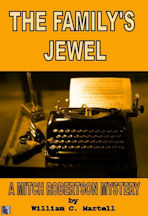
***
MITCH ROBERTSON #2: THE FAMILY'S JEWEL *** - For Kindle!
"The Presidential Suite of the Hollywood Hoover Hotel looked like a bloody battlefield: bodies everywhere, furniture broken, red liquid dripping from the walls, dead soldiers littering the elegant Berber rug as clouds of smoke overhead bounced between two air conditioning vents.
Mitch Robertson stepped over the body of an ex-child star turned sex tape star turned pop star and entered the room, spotted a gun on the floor and picked it up... careful not to spill his coffee with three pumps of mocha syrup from Penny’s Coffee Shop. That coffee was gold, the only thing keeping him going in this dazed state of wakefulness. The gun felt light. Holding it, he saw the silhouette of an 80s action star sitting sideways on a tipped over chair. Motionless. Was he dead? Mitch was still hung over from the Awards Party the night before, and wondered whether this was all some sort of crazy nightmare that he would wake up from... but when he tripped over the brown legs of a bottomless Superhero, flaccid junk encased in a condom but still wearing his mask, and hit the edge of the sofa, gun skittering and coffee spilling, he realized that it was all very real. What the hell had happened here?"
Short Novel. Only 99 cents - and no postage!
IT'S NEW!!
All About Rewrites!
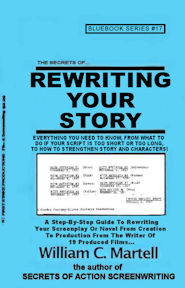
REWRITES Blue Book!
Rewriting In Waves?
When You Finish Your Screenplay Or Novel...
The Rewrites Begin!
The end is just the beginning! You’ve finished your story, but now the rewriting begins! This 405 page book shows you how to rewrite your screenplay or novel to perfection. Everything from Character Consistency to Shoeboxing to How To Give And Receive Notes to 15 Solutions If Your Script’s Too Long! and 15 Solutions If Your Script’s Too Short! to Finding The Cause Of A Story Problem to Good Notes Vs. Bad Notes to Finding Beta Readers to Avoiding Predictability to Learning To Be Objective About Your Work to Script Killer Notes and Notes From Idiots to Production Rewrites and What The Page Colors Mean? and a Complete Rewrite Checklist! The complete book on Rewriting Your Story!
Only: $4.99
HITCHCOCK FOR WRITERS!
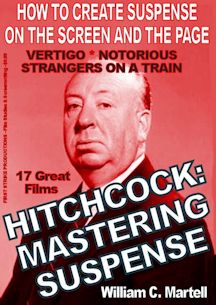
LEARN SUSPENSE FROM THE MASTER!
*** HITCHCOCK: MASTERING SUSPENSE *** - For Kindle!
Alfred Hitchcock, who directed 52 movies, was known as the *Master Of Suspense*; but what exactly is suspense and how can *we* master it? How does suspense work? How can *we* create “Hitchcockian” suspense scenes in our screenplays, novels, stories and films?
This book uses seventeen of Hitchcock’s films to show the difference between suspense and surprise, how to use “focus objects” to create suspense, the 20 iconic suspense scenes and situations, how plot twists work, using secrets for suspense, how to use Dread (the cousin of suspense) in horror stories, and dozens of other amazing storytelling lessons. From classics like “Strangers On A Train” and “The Birds” and “Vertigo” and “To Catch A Thief” to older films from the British period like “The 39 Steps” and “The Man Who Knew Too Much” to his hits from the silent era like “The Lodger” (about Jack The Ripper), we’ll look at all of the techniques to create suspense!
Only $5.99
NO KINDLE REQUIRED! Get the *free* app (any device, except your Mr. Coffee) on the order page on Amazon!
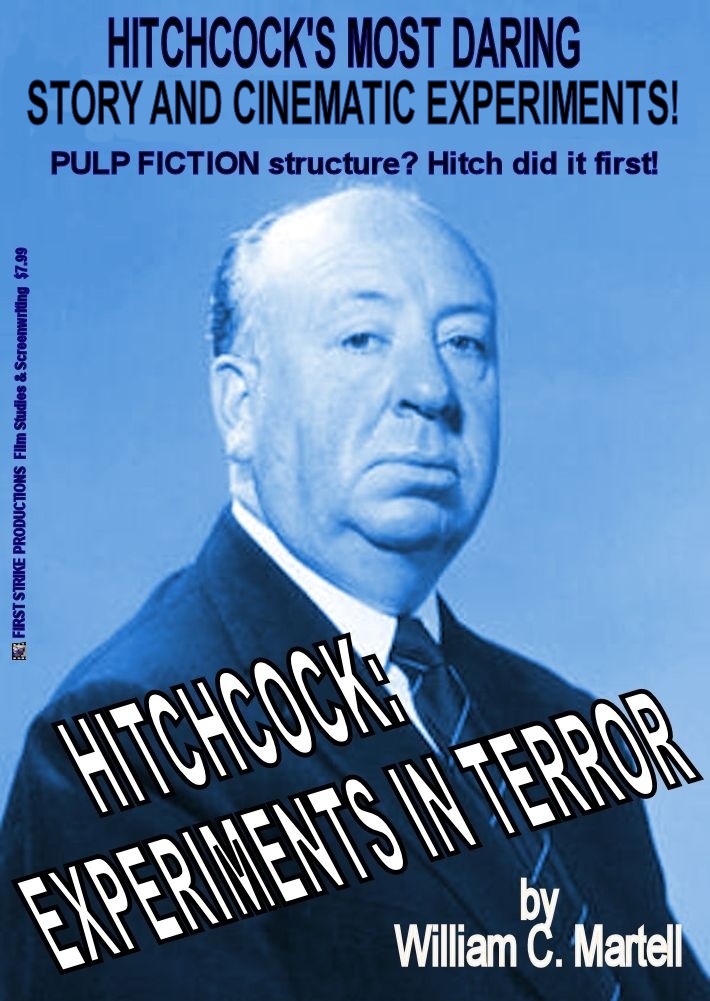
Strange Structures!
*** HITCHCOCK: EXPERIMENTS IN TERROR! *** - For Kindle!
***
Contained Thrillers like "Buried"? Serial Protagonists like "Place Beyond The Pines"? Multiple Connecting Stories like "Pulp Fiction"? Same Story Multiple Times like "Run, Lola, Run"?
HITCHCOCK DID IT FIRST!
This book focuses on 18 of Hitchcock's 52 films with wild cinema and story experiments which paved the way for modern films. Almost one hundred different experiments that you may think are recent cinema or story inventions... but some date back to Hitchcock's *silent* films! We'll examine these experiments and how they work. Great for film makers, screenwriters, film fans, producers and directors.
Only $5.99 - and no postage!
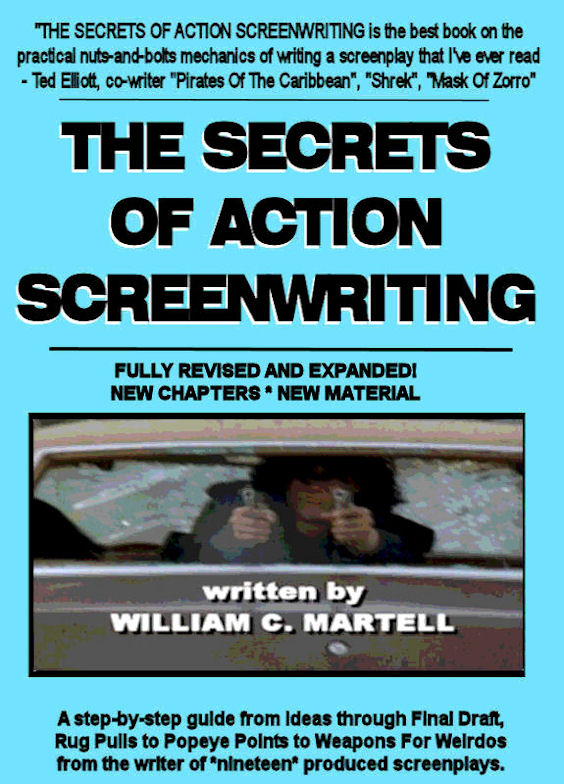
MAKES A GREAT GIFT!
*** THE SECRETS OF ACTION SCREENWRITING *** - For Kindle!
*** THE SECRETS OF ACTION SCREENWRITING *** - For Nook!
Why pay $510 for a used version of the 240 page 2000 version that used to retail for $21.95? (check it out!) when
you can get the NEW EXPANDED VERSION - over 500 pages - for just $9.99? New chapters, New examples, New techniques!
"SECRETS OF ACTION SCREENWRITING is the
best book on the practical nuts-and-bolts mechanics of writing a screenplay I've ever read."
- Ted Elliott, co-writer of MASK OF ZORRO, SHREK, PIRATES OF THE CARIBBEAN and the sequels (with Terry Rossio). (ie; 4 of the top 20 Box Office Hits Of ALL TIME.)
Only $9.99 - and no postage!
Tip FAQ

My New Script Secrets Newsletter!

STORY IN ACTION SERIES!

THE MISSION IMPOSSIBLE MOVIES
NEW: Updates On Films 7 & 8 Casting!
All Six Movies analyzed! All of the mission tapes, all of the “that’s impossible!” set pieces and stunts, the cons and capers - and how these scenes work, the twists and double crosses, the tension and suspense (and how to generate it), the concept of each film as a stand alone with a different director calling the shots (broken in the sixth film), the gadgets, the masks, the stories, the co-stars and team members (one team member has been in every film), the stunts Tom Cruise actually did (and the ones he didn’t), and so much more! Over 120,000 words of fun info!
THE MISSION IMPOSSIBLE MOVIES - 347 Pages - Only $3.99 !

BRAND NEW!
*** THE BOURNE MOVIES
NEW: Updates on TREADSTONE TV show!
All five "Bourne" movies (including "Legacy" and it's potential sequels) - what are the techniques used to keep the characters and scenes exciting and involving? Reinventing the thriller genre...
or following the "formula"? Five films - each with an interesting experiment! A detailed analysis of each
of the films, the way these thrillers work... as well as a complete list of box office and critical
statistics for each film. This book is great for writers, directors, and just fans of the series.
Only $3.99 - and no postage!
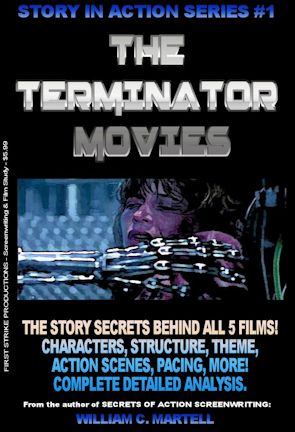
Over 240 pages!
*** THE TERMINATOR MOVIES *** - For Kindle!
He's back! The release of "Terminator: Dark Fate" is set to begin a new trilogy in
the Terminator story... 35 years after the first film was released. What draws us to these films about
a cybernetic organism from the future sent back in time? Why is there a new proposed trilogy every few
years? This book looks at all five Terminator movies from a story standpoint - what makes them work
(or not)? What are the techniques used to keep the characters and scenes exciting and involving? How
about those secret story details you may not have noticed? Containing a detailed analysis of each of
the five films so far, this book delves into the way these stories work... as well as a complete list of
box office and critical statistics for each film. This book is great for writers, directors, and just
fans of the series.
ONLY $3.99 - and no postage!
NO KINDLE REQUIRED! Get the *free* app (any device, except your Mr. Coffee) on the order page on Amazon!

NEW BUT OLD!
*** VINTAGE #1: HOW TO WRITE PHOTOPLAYS *** - For Kindle!
***
Screenwriting books have been around as long as films have. This series reprints vintage screenwriting books with a new introduction and history, plus new articles which look at how these lessons from almost 100 years ago apply to today’s screenplays. Anita Loos book is filled with information which still applies.
In addition to the full text of the original book, you get the full screenplay to Miss Loos' hit THE LOVE EXPERT, plus several new articles on the time period and women in Hollywood.
Only $2.99 - and no postage!
THE BLUE BOOKS!
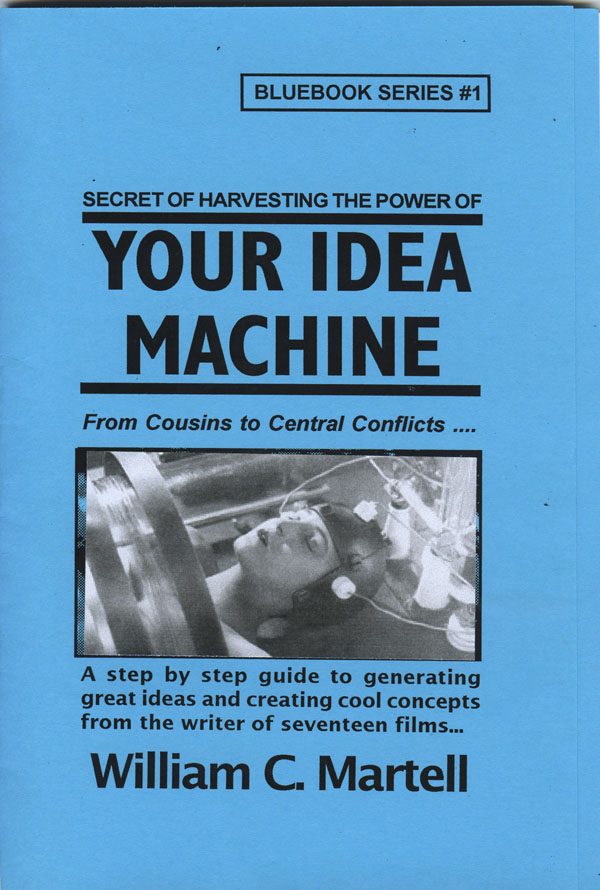
FIND A GREAT IDEA!
*** YOUR IDEA MACHINE *** - For Kindle!
****
Expanded version with more ways to find great ideas! Your screenplay is going to begin with an idea. There are good ideas and bad ideas and commercial ideas and personal ideas. But where do you find ideas in the first place? This handbook explores different methods for finding or generating ideas, and combining those ideas into concepts that sell. The Idea Bank, Fifteen Places To Find Ideas, Good Ideas And Bad Ideas, Ideas From Locations And Elements, Keeping Track Of Your Ideas, Idea Theft - What Can You Do? Weird Ways To Connect Ideas, Combing Ideas To Create Concepts, High Concepts - What Are They? Creating The Killer Concept, Substitution - Lion Tamers & Hitmen, Creating Blockbuster Concepts, Magnification And The Matrix, Conflict Within Concept, Concepts With Visual Conflict, Avoiding Episodic Concepts, much more! Print version is 48 pages, Kindle version is over 175 pages!
Only $4.99 - and no postage!
FIGURE OUT YOUR STORY!
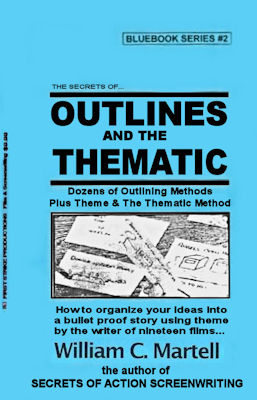
OUTLINES & THE THEMATIC Blue Book.
ARE YOUR SCENES IN THE RIGHT ORDER?
AND ARE THEY THE RIGHT SCENES?
Your story is like a road trip... but where are you going? What's the best route to get there? What are the best sights to see along the way? Just as you plan a vacation instead of just jump in the car and start driving, it's a good idea to plan your story. An artist does sketches before breaking out the oils, so why shouldn't a writer do the same? This Blue Book looks at various outlining methods used by professional screenwriters like Wesley Strick, Paul Schrader, John August, and others... as well as a guest chapter on novel outlines. Plus a whole section on the Thematic Method of generating scenes and characters and other elements that will be part of your outline. The three stages of writing are: Pre-writing, Writing, and Rewriting... this book looks at that first stage and how to use it to improve your screenplays and novels.
Only $4.99 - and no postage!
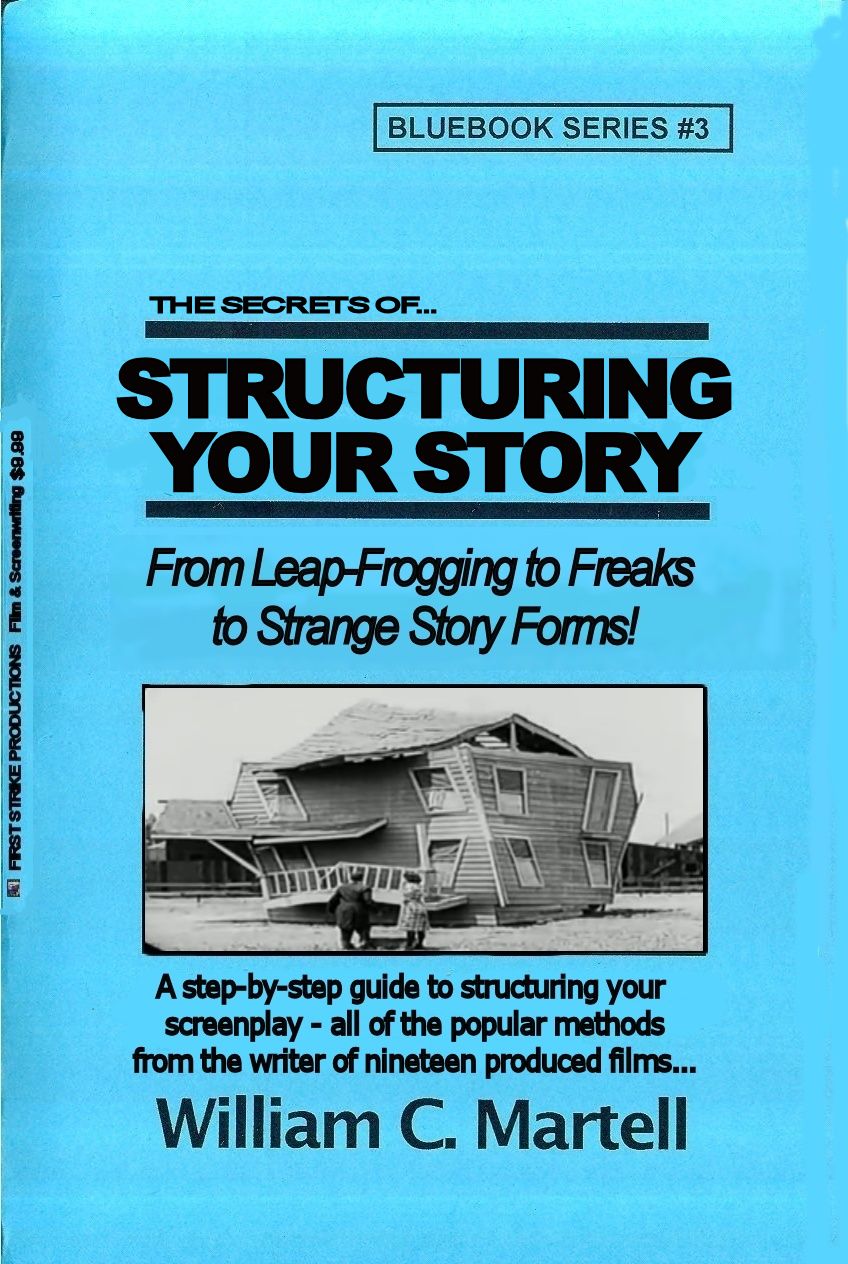
GOT STRUCTURE?!
*** STRUCTURING YOUR STORY *** - For Kindle!
William Goldman says the most important single element of any screenplay is structure. It’s the skeleton under the flesh and blood of your story. Without it, you have a spineless, formless, mess... a slug! How do you make sure your structure is strong enough to support your story? How do you prevent your story from becoming a slug? This Blue Book explores different types of popular structures from the basic three act structure to more obscure methods like leap-frogging. We also look at structure as a verb as well as a noun, and techniques for structuring your story for maximum emotional impact. Most of the other books just look at *structure* and ignore the art of *structuring* your story. Techniques to make your story a page turner... instead of a slug!
Only $4.99 - and no postage!
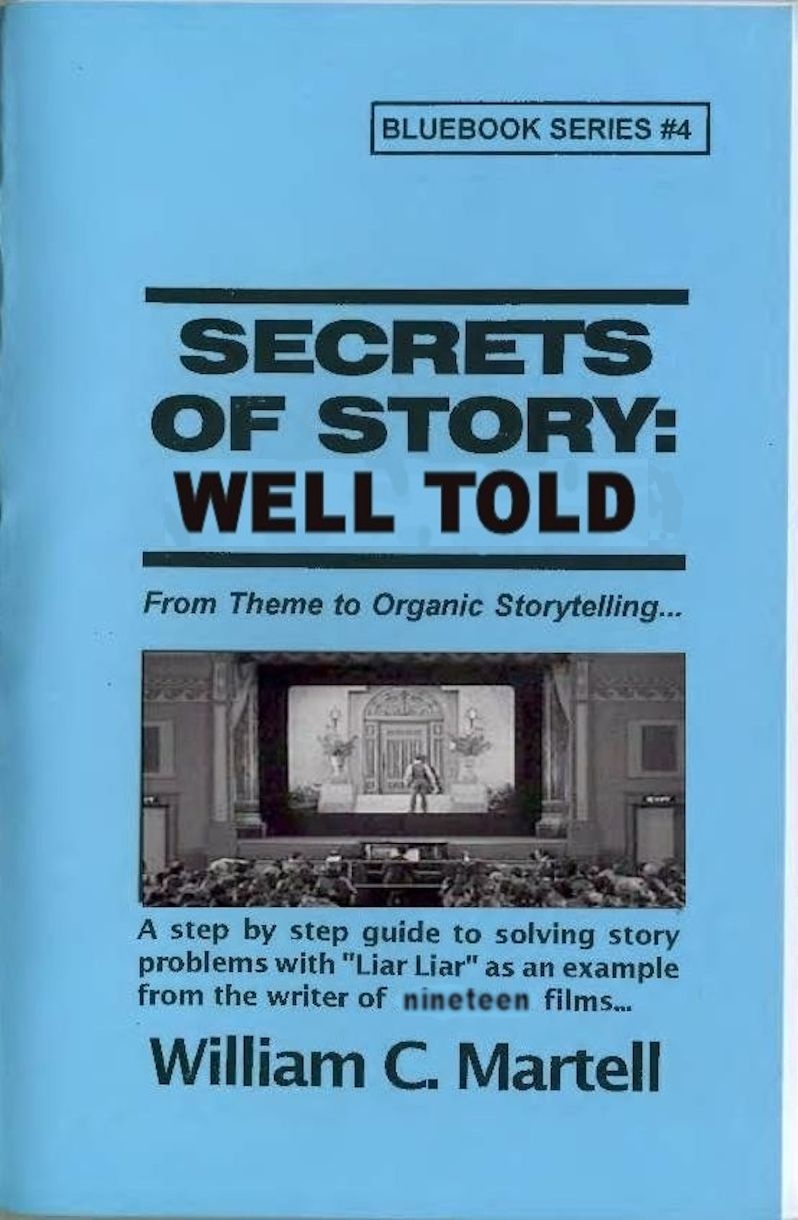
STORY: WELL TOLD!
*** STORY: WELL TOLD *** - For Kindle!
This book takes you step-by-step through the construction of a story... and how to tell a story well, why Story always starts with character... but ISN'T character, Breaking Your Story, Irony, Planting Information, Evolving Story, Leaving No Dramatic Stone Unturned, The Three Greek Unities, The Importance Of Stakes, The Thematic Method, and how to create personal stories with blockbuster potential. Ready to tell a story?
Print version was 48 pages, Kindle version is over 85,000 words - 251 pages!
Only $4.99 - and no postage!

START STRONG!
*** HOOK 'EM IN TEN *** - For Kindle!
Your story doesn't get a second chance to make a great first impression, and this book shows you a
bunch of techniques on how to do that. From the 12 Basic Ways To Begin Your Story, to the 3 Stars Of
Your First Scene (at least one must be present) to World Building, Title Crawls, Backstory, Starting
Late, Teasers and Pre Title Sequences, Establishing Theme & Motifs (using GODFATHER PART 2), Five Critical
Elements, Setting Up The Rest Of The Story (with GODFATHER), and much more! With hundreds of examples
ranging from Oscar winners to classic films like CASABLANCA to some of my produced films (because
I know exactly why I wrote the scripts that way). Biggest Blue Book yet!
Print version was 48 pages, Kindle version is over 100,000 words - 312 pages!
Only $4.99 - and no postage!
NO KINDLE REQUIRED! Get the *free* app (any device, except your Mr. Coffee) on the order page on Amazon!
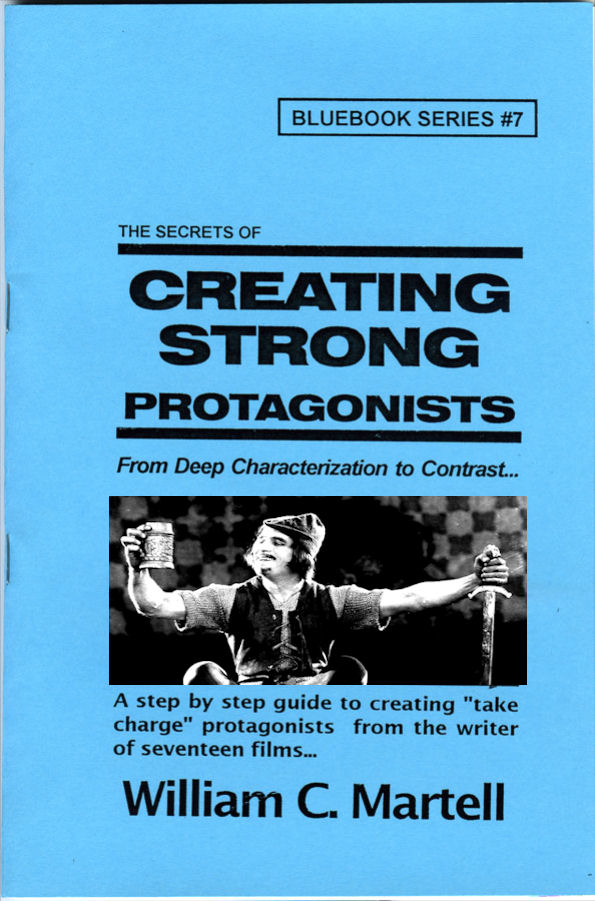
MOVIES ARE CHARACTERS!
*** CREATING STRONG PROTAGONISTS *** - For Kindle!
*** CREATING STRONG PROTAGONISTS *** - For Nook!
Expanded version with more ways to create interesting protagonists! A step-by-step guide to creating "take charge" protagonists. Screenplays are about characters in conflict... characters in emotional turmoil... Strong three dimensional protagonists who can find solutions to their problems in 110 pages. But how do you create characters like this? How do you turn words into flesh and blood? Character issues, Knowing Who Is The Boss, Tapping into YOUR fears, The Naked Character, Pulp Friction, Man With A Plan, Character Arcs, Avoiding Cliche People, Deep Characterization, Problem Protagonists, 12 Ways To Create Likable Protagonists (even if they are criminals), Active vs. Reactive, The Third Dimension In Character, Relationships, Ensemble Scripts, and much, much more. Print version is 48 pages, Kindle version is once again around 205 pages!
ONLY $4.99 - and no postage!
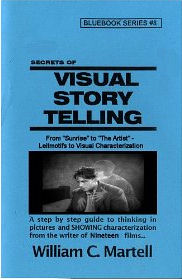
I WRITE PICTURES!
*** VISUAL STORYTELLING *** - For Kindle! (exclusive)
Show Don't Tell - but *how* do you do that? Here are techniques to tell stories visually! Using Oscar Winning Films and Oscar Nominated Films as our primary examples: from the first Best Picture Winner "Sunrise" (1927) to the Oscar Nominated "The Artist" (which takes place in 1927) with stops along the way Pixar's "Up" and Best Original Screenplay Winner "Breaking Away" (a small indie style drama - told visually) as well as "Witness" and other Oscar Winners as examples... plus RISE OF THE PLANET OF THE APES. Print version is 48 pages, Kindle version is over 200 pages!
ONLY $4.99 - and no postage!
DESCRIPTION & VOICE Blue Book!
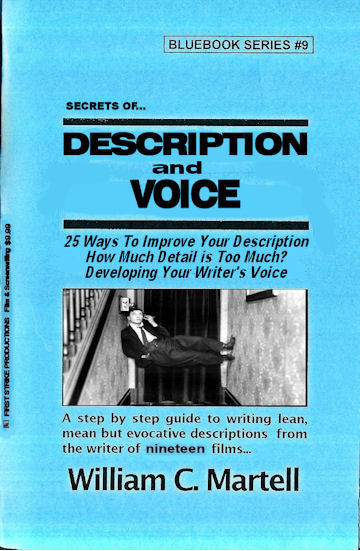
DESCRIPTION & VOICE Blue Book.
IS HALF OF YOUR STORY IN TROUBLE?
Most screenplays are about a 50/50 split between dialogue and description - which means your description is just as important as your dialogue. It just gets less press because the audience never sees it, the same reason why screenwriters get less press than movie stars. But your story will never get to the audience until readers and development executives read your script... so it is a very important factor. Until the movie is made the screenplay is the movie and must be just as exciting as the movie. So how do you make your screenplay exciting to read? Description is important in a novel as well, and the “audience” does read it... how do we write riveting description?
Only $4.99 and no postage!

PRO DIALOGUE TECHNIQUES!
*** DIALOGUE SECRETS *** - For Kindle!
***
Expanded version with more ways to create interesting dialogue! How to remove bad dialogue (and what *is* bad dialogue), First Hand Dialogue, Awful Exposition, Realism, 50 Professional Dialogue Techniques you can use *today*, Subtext, Subtitles, Humor, Sizzling Banter, *Anti-Dialogue*, Speeches, and more. Tools you can use to make your dialogue sizzle! Special sections that use dialogue examples from movies as diverse as "Bringing Up Baby", "Psycho", "Double Indemnity", "Notorious", the Oscar nominated "You Can Count On Me", "His Girl Friday", and many more! Print version is 48 pages, Kindle version is over 175 pages!
Only $4.99 - and no postage!

WHAT IS A SCENE?
*** SCENE SECRETS *** - For Kindle!
***
What is a scene and how many you will need? The difference between scenes and sluglines. Put your scenes on trial for their lives! Using "Jaws" we'll look at beats within a scene. Scene DNA. Creating set pieces and high concept scenes. A famous director talks about creating memorable scenes. 12 ways to create new scenes. Creating unexpected scenes. Use dramatic tension to supercharge your scenes. Plants and payoffs in scenes. Plus transitions and buttons and the all important "flow"... and more! Over 65,000 words! Print version was 48 pages, Kindle version is around 210 pages!
Only $4.99 - and no postage!
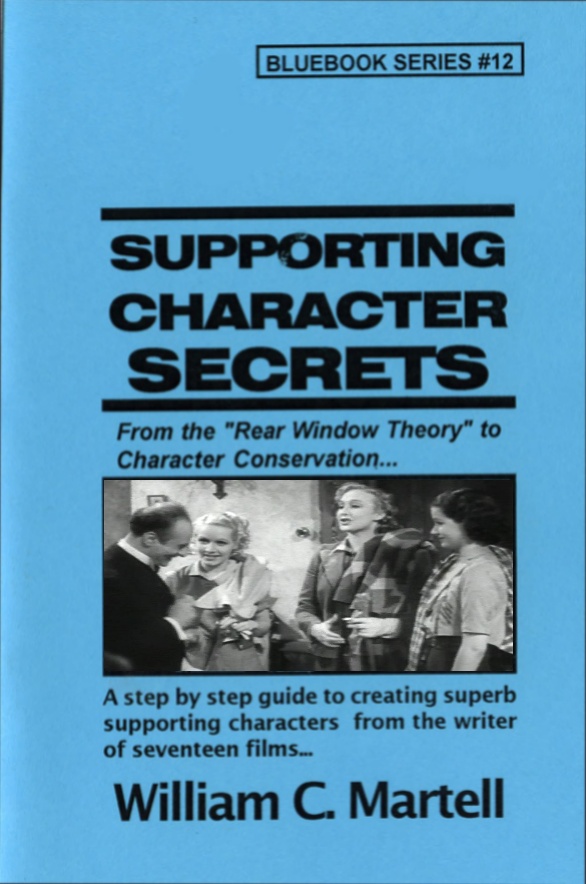
SUBPLOTS?
*** SUPPORTING CHARACTER SECRETS *** - For Kindle! (Exclusive)
Expanded version with more techniques to flesh out your Supporting Characters and make them individuals. Using the hit movie BRIDESMAIDS as well as other comedies like THE HANGOVER and TED and HIGH FIDELITY and
40 YEAR OLD VIRGIN and many other examples we look at ways to make your Supporting Characters come alive on the page.
Print version was 48 pages, Kindle version is around 170 pages!
ONLY $4.99 - and no postage!
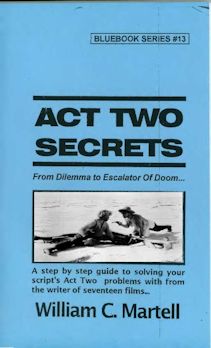
ACT TWO SOLUTIONS!
*** ACT TWO SECRETS *** - For Kindle!
Expanded version with more techniques to help you through the desert of Act Two! Subjects Include: What Is Act Two? Inside Moves, The 2 Ps: Purpose & Pacing, The 4Ds: Dilemma, Denial, Drama and Decision, Momentum, the Two Act Twos, Subplot Prisms, Deadlines, Drive, Levels Of Conflict, Escalation, When Act Two Begins and When Act Two Ends, Scene Order, Bite Sized Pieces, Common Act Two Issues, Plot Devices For Act Two, and dozens of others. Over 67,000 words (that’s well over 200 pages) of tools and techniques to get you through the desert of Act Two alive!
Print version was 48 pages, Kindle version is well over 200 pages!
ONLY $4.99 - and no postage!
All About Endings!
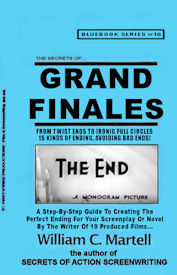
GRAND FINALES Blue Book!
The Perfect Ending For Your Story!
The First Ten Pages Of Your Screenplay Are Critical,
But What About The Last 10 Pages?
Creating the perfect ending to your story! This 100,000 word book shows you how to end your story with a bang, rather than a whimper. Everything from Resolution Order to Act Three Tools to Happy or Sad Endings? to How The Beginning Of Your Story Has Clues To The Ending (in case you were having trouble figuring out how the story should end) to Falling Action to How To Avoid Bad Endings to Writing The Perfect Twist Ending to Setting Up Sequels & Series to Emotional Resolutions to How To Write Post Credit Sequences to Avoiding Deus Ex Machinas, to 20 Different Types Of Ends (and how to write them) and much more! Everything about endings for your screenplay or novel!
Only: $4.99
NO KINDLE REQUIRED! Get the *free* app (any device, except your Mr. Coffee) on the order page on Amazon!
All About LOGLINES, TREATMENTS, and PITCHING!

LOGLINES, TREATMENTS, and PITCHING! Blue Book!
Distilling Your Screenplay!
Loglines, Treatments, Pitching, Look Books, Pitch Decks, One Pagers, Rip-O-Matics?
You have written a brilliant 110 page screenplay, but how do you get anyone to read it? You need to distill it down into some form of verbal moonshine or story rocket fuel that will ignite that bored development executive or manager or agent and get them to request your screenplay. But how do you shrink those 110 pages into a 25 word logline or a 2 minute elevator pitch or a one page synopsis or a short paragraph? This 100,000 word book shows you how! Everything you need to know! From common logline mistakes (and how to solve them) to how your pitch can reveal story problems to the 4 types of pitches!
272 Pages - ONLY $4.99!
READY TO BREAK IN?
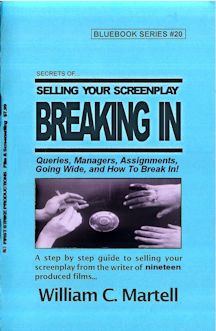
THE BUISINESS SIDE
*** BREAKING IN BLUE BOOK *** - For Kindle!
Should really be called the BUSINESS BLUE BOOK because it covers almost everything you will need to
know for your screenwriting career: from thinking like a producer and learning to speak their language,
to query letters and finding a manager or agent, to making connections (at home and in Hollywood) and
networking, to the different kinds of meetings you are will have at Studios, to the difference between
a producer and a studio, to landing an assignment at that meeting and what is required of you when you
are working under contract, to contracts and options and lawyers and... when to run from a deal!
Information you can use *now* to move your career forward! It's all here in the Biggest Blue Book yet!
Print version was 48 pages, Kindle version is over 400 pages!
$4.99 - and no postage!

Use your creative energy to focus on the content; let Final Draft take care of the style. Final Draft is the number-one selling application specifically designed for writing movie scripts, television episodics and stage plays. Its ease-of-use and time-saving features have attracted writers for almost two decades positioning Final Draft as the Professional Screenwriters Choice. Final Draft power users include Academy, Emmy and BAFTA award winning writers like Oliver Stone, Tom Hanks, Alan Ball, J.J. Abrams, James Cameron and more.
* * * Buy It!
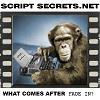
|
|
|
|
|
SECRETS OF ACTION SCREENWRITING
|
|
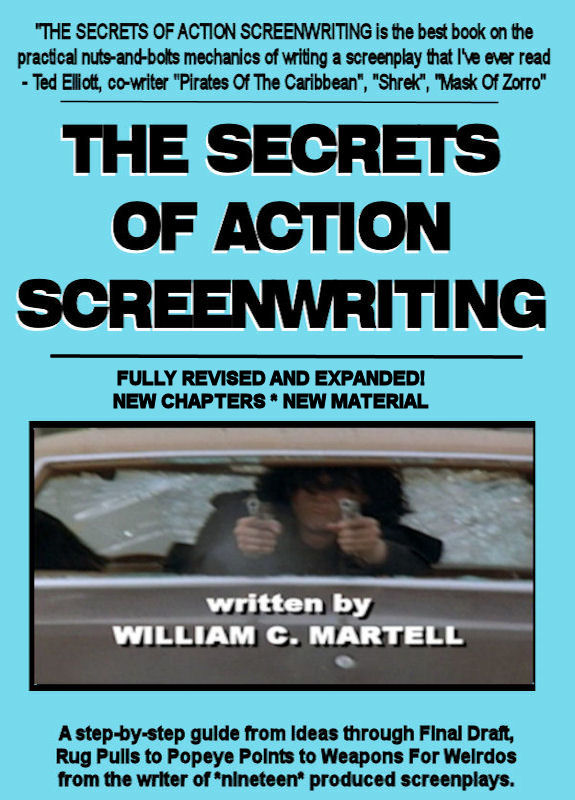 IT'S BACK! SECRETS OF ACTION SCREENWRITING
IT'S BACK! SECRETS OF ACTION SCREENWRITING
Over 460 pages packed with tips and techniques.
How to
write a plot twist,
the four kinds of suspense (and how to create it), reversals, ten ways to invent new action scenes, secrets and lies,
creating the ultimate
villain, five kinds of love interests, MORE! CLICK HERE!
|
|
CLASSES ON MP3
|
|
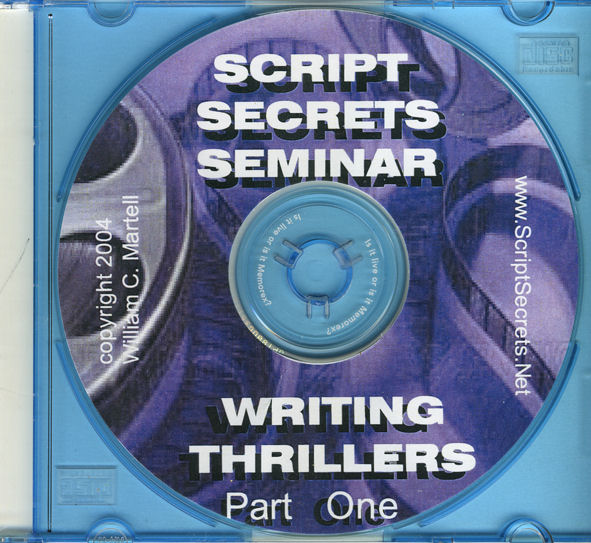 CLASSES ON MP3! Take a class on MP3! GUERRILLA MARKETING - NO AGENT? NO PROBLEM! and WRITING THRILLERS (2 MP3s). Full length classes on MP3. Now Available: IDEAS & CREATIVITY, WRITING HORROR, WRITING INDIE FILMS, more!
CLASSES ON MP3! Take a class on MP3! GUERRILLA MARKETING - NO AGENT? NO PROBLEM! and WRITING THRILLERS (2 MP3s). Full length classes on MP3. Now Available: IDEAS & CREATIVITY, WRITING HORROR, WRITING INDIE FILMS, more!
Take classes on MP3!
|
|
MY OTHER SITES
|
|
B MOVIE WORLD
Cult Films, Exploitation, Bikers & Women In Prison, Monster Movies.
FIRST STRIKE PRODUCTIONS
Producing my own scripts, investment possibilities, pipe dreams.
|
|
NAKED SCREENWRITING MP3s
|
|
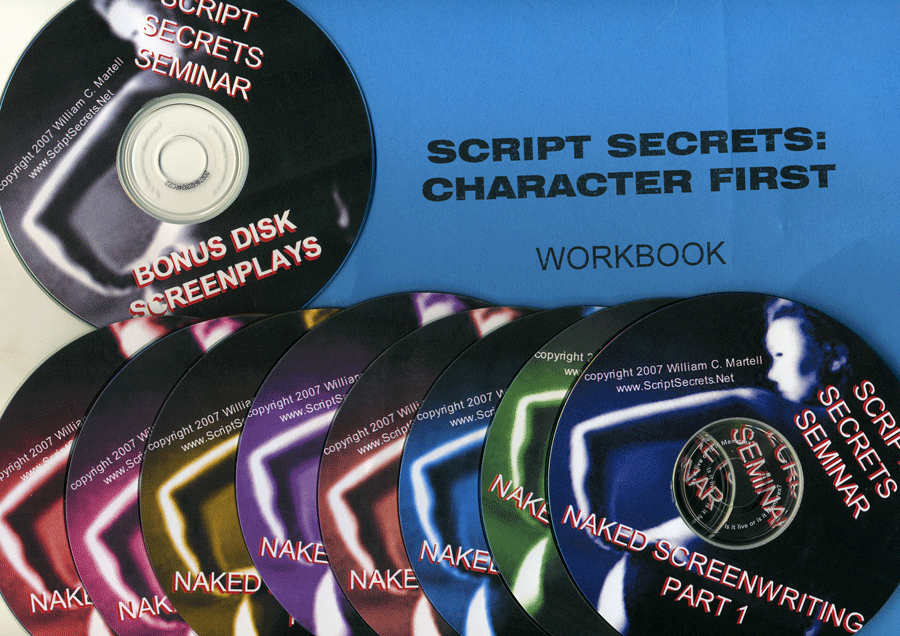 The NAKED SCREENWRITING CLASS ON MP3!
The 2001 London Class on 8 MP3s! Recorded *live* the morning after the Raindance Film Festival
wrapped. The two day class on 8CD worth, plus a workbook, plus a bonus CD.
The NAKED SCREENWRITING CLASS ON MP3!
The 2001 London Class on 8 MP3s! Recorded *live* the morning after the Raindance Film Festival
wrapped. The two day class on 8CD worth, plus a workbook, plus a bonus CD.
The 2 Day Class on MP3!
|
|
ONLINE CLASSES
|
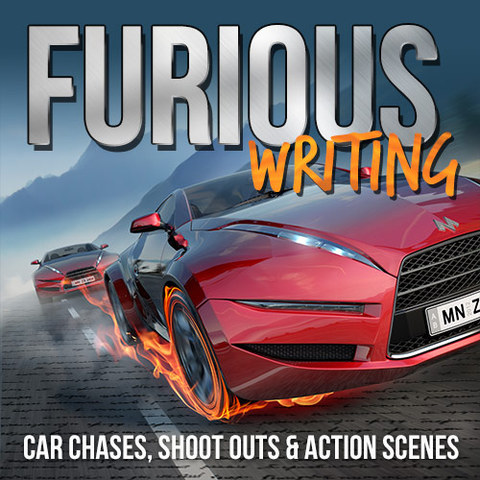
|
|
BILL'S CORNER
|
|
My
nineteen produced films, interviews with me in magazines,
several sample scripts, my available scripts list... And MORE!
...............................BILL'S CORNER
Available Scripts
|
|
E BOOKS PAGE
|
|
 E BOOKS: New Blue Books and Novelettes!
E BOOKS: New Blue Books and Novelettes!
I am expanding all of the Blue Books from around 44 pages of
text to around 200 pages! Some are over 250 pages! See what is availabale and what is coming soon!Also, I've been writing Novelletes and there
will soon be novels.
E BOOKS: BLUE BOOKS & NOVELLETES
|
|
BOOKLETS & PRODUCTS
|
|
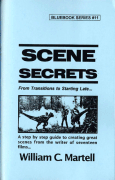 FIRST STRIKE BLUE BOOKS
FIRST STRIKE BLUE BOOKS
Each Blue Book is 48
pages and focuses on a different aspect of screenwriting. Dialogue. Visual Storytelling. Your First Ten Pages. Act 2 Booster. Protagonists. Great Endings.
Seventeen Blue Books now available!
THE SECRETS OF ACTION SCREENWRITING OUT OF PRINT!
|
|
|
|
|

